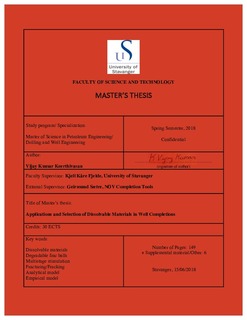| dc.contributor.advisor | Fjelde, Kjell Kåre | |
| dc.contributor.advisor | Sætre, Geirmund | |
| dc.contributor.author | Keerthivasan, Vijay Kumar | |
| dc.coverage.spatial | Norway | nb_NO |
| dc.date.accessioned | 2018-10-24T12:45:57Z | |
| dc.date.available | 2018-10-24T12:45:57Z | |
| dc.date.issued | 2018-06-15 | |
| dc.identifier.uri | http://hdl.handle.net/11250/2569355 | |
| dc.description | Master's thesis in Petroleum Engineering | nb_NO |
| dc.description.abstract | Dissolvable materials are an emerging technology in the petroleum industry with multiple areas of application, the chief among them being multistage well stimulation. The challenges associated with removal of traditional frac balls in sleeve-based multistage stimulation has seen a surge in demand for the use of dissolvable balls.
Selecting the right dissolvable frac ball for a given operational constraint and downhole condition has been a major barrier to their widespread adoption and commercialisation. The present qualification process of dissolvable balls involves multiple iterations of extensive full-scale tests on several materials until the acceptance criteria for the specific application are fulfilled. There is a distinct lack of information in existing scientific literature on how to systematically select the optimal dissolvable ball. The main goal of this thesis is to simplify this tedious selection process.
A series of experiments were conducted on four dissolvable cylindrical samples from National Oilwell Varco (NOV) to characterise their responses to various test conditions. Empirical models of the dissolution rates were developed based on regression analysis of the experimental data. Thereafter, an analytical model was formulated to forecast the downhole performance of dissolvable frac balls. Finally, the empirical and analytical models were utilised to devise a stepwise workflow that enables selection of the most suitable dissolvable ball type to fulfil the operator’s requirements.
This novel workflow eliminates the need for excessive full-scale qualification testing, thereby resulting in substantial cost-savings for the company while drastically improving the overall efficiency and reliability of the selection process. | nb_NO |
| dc.language.iso | eng | nb_NO |
| dc.publisher | University of Stavanger, Norway | nb_NO |
| dc.relation.ispartofseries | Masteroppgave/UIS-TN-IEP/2018; | |
| dc.subject | petroleumsteknologi | nb_NO |
| dc.subject | petroleum engineering | nb_NO |
| dc.subject | boreteknologi | nb_NO |
| dc.subject | drilling engineering | nb_NO |
| dc.subject | dissolvable | nb_NO |
| dc.subject | degradable | nb_NO |
| dc.subject | frac | nb_NO |
| dc.subject | multistage | nb_NO |
| dc.subject | stimulation | nb_NO |
| dc.subject | fracturing | nb_NO |
| dc.subject | fracking | nb_NO |
| dc.subject | analytical | nb_NO |
| dc.subject | empirical | nb_NO |
| dc.subject | rate of dissolution | nb_NO |
| dc.subject | magnesium | nb_NO |
| dc.subject | balls | nb_NO |
| dc.subject | completions | nb_NO |
| dc.subject | NOV | nb_NO |
| dc.subject | national oilwell varco | nb_NO |
| dc.title | Applications and Selection of Dissolvable Materials in Well Completions | nb_NO |
| dc.type | Master thesis | nb_NO |
| dc.subject.nsi | VDP::Teknologi: 500::Berg‑ og petroleumsfag: 510::Petroleumsteknologi: 512 | nb_NO |
